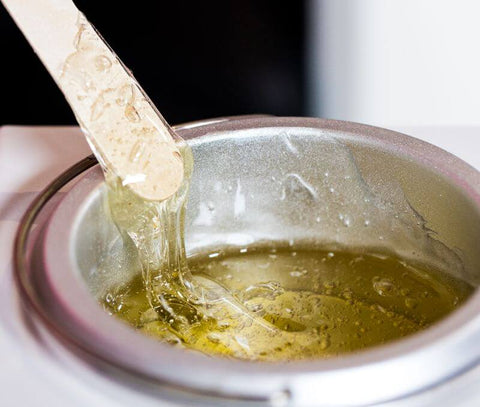For decades, hair removal methods have been more prevalent among women. In recent years, there has been a growing trend among men to move beyond traditional shaving and trimming, with Brazilian waxing becoming a favored technique for grooming the bikini area. How does the process of waxing unfold? What should be done to ensure a painless experience when waxing the intimate area? If you’re curious about these questions, let’s explore together and find the answers.

What Is a Brazilian Wax for Men?
Brazilian Wax for men is a method of removing hair from the entire genital area. This technique typically involves using hot wax to eliminate all hair in the genital region, including the pubic area, scrotum, groin, and anus. Performing this process helps achieve smooth and hair-free skin, often preferred for its cleanliness, aesthetic appeal, and enhanced comfort. However, the waxing procedure can be painful and irritating for some individuals.
How to prepare for Your Brazilian Wax

So you’ve decided to try waxing. Whether you’re targeting your legs, bikini line, or another area, the anticipation of your first appointment can be exciting and maybe even a little nerve-wracking. But fear not! With a little preparation, you can ensure a smooth and comfortable waxing experience.
Prepping Your Skin:
- Consultation: This is crucial, allowing you to discuss any concerns, desired outcomes, and medical conditions.
- Preparation: Exfoliate 2-3 days prior to remove dead skin and prevent ingrown hairs. The technician will cleanse and apply a pre-wax oil to enhance the process.
- Hair Length: Ideally, hair should be between 1/4″ and 1/2″ long for optimal adherence to the wax.
What to expect during a male Brazilian wax
Positioning
- You will be escorted to a private room where the waxing will take place.
- The technician will guide you onto a specially designed bed that allows for comfortable positioning and optimal access to the area being waxed.
- Depending on the area being waxed, you may be asked to lie down on your back, side, or with your legs spread apart.
- The technician will ensure you are comfortable and properly positioned before proceeding.
Application
- The technician will begin by cleansing the area to be waxed with a pre-waxing solution to remove any dirt or residue.
- They will then apply a thin layer of warm wax in the direction of hair growth, ensuring that all hairs are covered.
- The type of wax used may vary depending on your skin type and sensitivity. Some waxes are formulated with soothing ingredients like aloe vera or chamomile to help minimize discomfort.
- You may use a small spatula or roller to apply the wax evenly and precisely.
Removal
- Once the wax has hardened, the technician will use a strip of cloth or paper to quickly pull it off, removing the hair from the root.
- The movement will be swift and controlled to minimize discomfort.
- Users may apply additional pressure to areas with thicker or more stubborn hair.
- After each strip is removed, the technician will apply a soothing lotion or oil to calm the skin and remove any residual wax.
Addressing Discomfort
While a certain level of discomfort is anticipated during the waxing process, it should generally be manageable. Individual sensitivity and the specific area being waxed can influence the degree of discomfort. For instance, the inner labia is often more sensitive than other areas. To alleviate any discomfort, it’s crucial to practice deep breathing and communicate openly with the technician if you experience pain. A skilled technician can adjust their technique or apply a numbing cream to enhance your comfort during the waxing procedure.
Brazilian Wax Aftercare

Exfoliate regularly: It prevents ingrown hairs by eliminating dead skin cells that may trap hair as it regrows.
Avoid using strong soaps and lotions: These can irritate the skin and contribute to ingrown hairs.
Wear loose-fitting clothing: Tight clothing can rub against the waxed skin, causing irritation.
Moisturize the skin: It keeps the skin hydrated and healthy, reducing the risk of irritation and ingrown hairs.
How painful is Brazilian wax?
The pain level experienced during a Brazilian wax can vary from person to person. For some individuals, the discomfort is relatively mild, while others may find it more intense. The sensation is often described as a quick and sharp sting as the wax is applied and swiftly removed, removing hair from the entire bikini area, including the front, back, and in-between. The pain tends to decrease with regular waxing sessions as the hair follicles weaken over time. Additionally, choosing a skilled and experienced esthetician, along with proper preparation and aftercare, can contribute to a more tolerable Brazilian waxing experience.
Does Waxing Reduce Hair Growth?
Yes, waxing can reduce hair growth over time. While it won’t stop hair growth permanently, it can significantly slow down the process and make hair appear finer and thinner. If you’re still unsure about the effects of a Brazilian wax, you can look up and refer to Brazilian wax before and after photos online.
The duration of a male Brazilian wax’s results varies depending on your individual hair growth rate. Typically, you can expect a smooth and hair-free appearance for about three to six weeks. To maintain optimal results, planning a return visit approximately every five weeks is recommended. This time frame allows the regrown hair to be softer, finer, and just long enough for effective waxing.
Some Differences Between Waxing Men And Women
Hair removal is a common beauty method for both men and women, but there are significant differences between the two genders. Men’s hair tends to be thicker and coarser, making the process more painful and requiring more frequent sessions. While men’s skin is thicker and more resilient, reducing the likelihood of irritation, it also produces more oil, necessitating careful post-hair removal care to prevent pore inflammation. Men often undergo hair removal in more extensive areas with thick and coarse hair, resulting in increased time and complexity of the process. In summary, male hair removal demands special care to minimize pain, prevent skin irritation, and ensure an effective technique.
FAQs
- Should I trim before my first Brazilian wax?
Yes, it’s advisable to trim before your first Brazilian wax. Trimming the hair to about a quarter-inch length ensures a more efficient and less painful waxing process. It allows the wax to adhere effectively and makes the overall experience more comfortable.
- What clothes to wear to a Brazilian wax?
You’re going to want to wear loose-fitting, cotton undies and something breathable, such as a dress or skirt, sweats, or a loose-fitting pair of jeans. I think the dress or skirt option is best that way you don’t have to completely undress. For your first time, wearing a dress might make you feel more comfortable.
- Does it hurt for a guy to get Brazilian wax?
Yes, getting a Brazilian wax can be uncomfortable for men, as the process involves removing hair from the sensitive bikini area. However, pain tolerance varies among individuals, and some may find it more tolerable with each session.
- What to expect when getting a Brazilian wax for men?
A fully executed male Brazilian also includes removing all hair from the scrotum, perineum, and anal region. The results typically last for about four to six weeks, so that gives you an idea of what your return on investment is. Waxing removes hair from the room, so prepare for a little redness afterwards.
- Can you receive oral after a Brazilian wax?
If they’re freshly trimmed, their pubic hair could potentially hurt your freshly waxed skin. “It’s going to get irritating. If it’s oral sex and they have a beard, that could be irritating, too. My recommendation is to always wait 24 hours, but again, it’s different for everyone.






